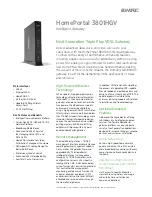
Comtech EF Data / Stampede
FX Series Administration Guide - Version 6.2.2
79
Chapter: FX Series Configuration
Section: Quality of Service
MN-FXSERIESADM6 Rev 6
3.4
Quality of Service
3.4.1
Theory of Operations for QoS and Traffic Shaping
Structure
There are two levels of groups and a third level of queues that can be configured. Traffic coming into
the appliance is separated by filters into the level 1 groups. This traffic can subsequently be
separated by filters into a second level of groups, and then filtered into queues where traffic will be
released to the WAN based on the QoS and shaping rules defined. The groups as well as the queues
have a MIR and a CIR defined that is used to control that amount of traffic that is allowed to pass
through the groups and queues to the WAN.
Links
Links represent physical connections within the network. Links are used to bring any data rate
limitations into the traffic shaper that is imposed by the physical connection. Each link can be a
point-to-point connection or it can be a point-to-multipoint connection. The network can have a mix
of links. Each of the far side points will have a peer FX. In the case of the point-to-multipoint link,
there is one peer for each remote “multipoint”. The link rate is the data rate of the outbound
modem. ACM as well as CCM is supported in the link, if ACM is enabled, then the FX will read the
data rate from the modem.
Traffic Shaping
The traffic shaper consists of two levels of groups and an additional level of queues. Traffic from the
queues is enabled onto the WAN interface. The groups are used to separate the traffic into the
appropriate queues. Each group can have a MIR and CIR data rate associated with it, which gives
further refinement on the traffic shaping.
A point-to-multipoint link can have Level 1 groups that span multiple remote points, all within the
same link. When doing WAN/OP functions, the peer FX will be automatically discovered, and once
discovered, WAN optimization will occur. However, when doing header compression, the remote
peer must be configured. This is done on the Level 2 Group configuration screen.
Each group has a CIR (Committed Information Rate) and MIR (Maximum Information Rate) associated
with it. Data moving through a group will have the same priority. Each peer group’s CIR will be met if
possible, if not, then each will get their share using Stochastic Fair Weighting. If the CIR’s can be met,
then each peer group will be allowed up to its MIR amount of traffic, again, sharing traffic using
Stochastic Fair Weighting.
Some care must be taken in setting the MIR’s and CIR’s. The sum of the CIR’s of the children need to
be less than or equal to the CIR of the parent. This means that the sum of the CIR’s of the queues
that children of a Level 2 Group must be less than that groups CIR, and the sum of the CIR’s of level 2
Groups that are children of a Llevel1 Group must be less than that groups CIR. A child’s MIR must be
less than or equal to its parents MIR.
Once data makes it to a queue, it can be released to the WAN based on group priority, CIR and MIR.
Traffic Control Properties
Queue drain algorithm:
This specifies the drain method for scheduling outbound packets for all Queue definitions. The drain
algorithm is set by the link and applies to all queues associated with that link.
Strict Priority:
In the Strict Priority Drain algorithm, higher priority queues are depleted before lower
priority queues pass traffic. Traffic is capped at the link rate.
















































